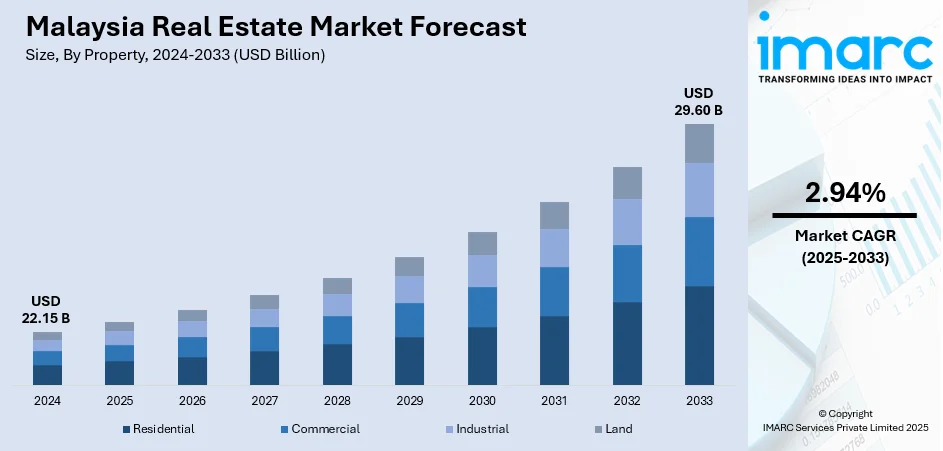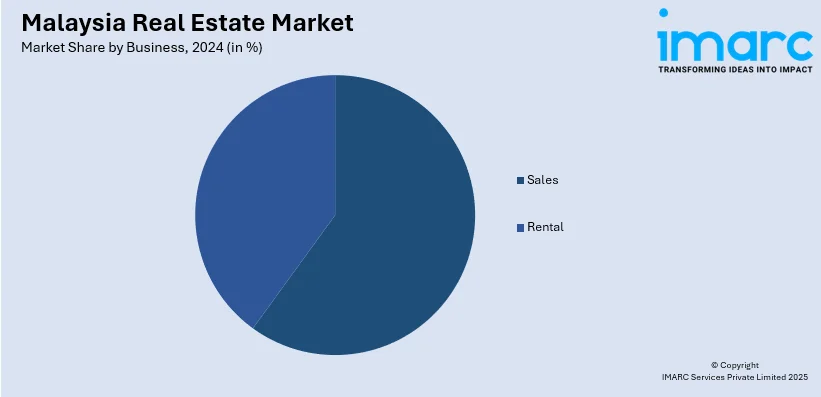
Malaysia Real Estate Market Size, Share, Trends and Forecast by Property, Business, Mode, and Region, 2025-2033
Malaysia Real Estate Market Overview:
The Malaysia real estate market size reached USD 22.15 Billion in 2024. The market is projected to reach USD 29.60 Billion by 2033, exhibiting a growth rate (CAGR) of 2.94% during 2025-2033. The market is showing consistent progress, supported by a recovering economy and increased construction activity. Urban migration and lifestyle changes are reshaping housing preferences, boosting demand for mixed-use developments and smart city projects. Foreign direct investments and digitalization in real estate services are also improving transparency and operational efficiency. The market is witnessing steady growth fueled by economic stability, infrastructure growth, and positive government policies. With these encouraging developments, the Malaysia real estate market share is anticipated to grow progressively in the next few years.
|
Report Attribute
|
Key Statistics
|
|---|---|
|
Base Year
|
2024
|
|
Forecast Years
|
2025-2033
|
|
Historical Years
|
2019-2024
|
| Market Size in 2024 | USD 22.15 Billion |
| Market Forecast in 2033 | USD 29.60 Billion |
| Market Growth Rate 2025-2033 | 2.94% |
Malaysia Real Estate Market Trends:
Infrastructure-Driven Real Estate Expansion
Malaysia’s property sector is evolving rapidly, supported by continuous improvements in national infrastructure. Major projects such as new rail lines, highways, and cross-border transport links are transforming accessibility across urban and suburban areas. Enhanced connectivity is driving renewed interest in secondary cities, suburban neighborhoods, and previously less accessible regions, creating new real estate growth corridors. These developments are encouraging both residential buyers and commercial investors to explore opportunities outside traditional city centers. Improved transport networks are also boosting the logistics and industrial sectors, with better accessibility lowering operational costs and attracting more businesses. The infrastructure upgrades are not only expanding development zones but also elevating the overall standard of urban planning. These long-term projects are aligning with government initiatives aimed at regional economic diversification. As these corridors mature, they are expected to contribute significantly to Malaysia real estate market growth, offering both stability and strong investment prospects for a diverse range of stakeholders.

To get more information on this market, Request Sample
Data‑Centre & Industrial Real Estate Surge
Malaysia’s real estate sector is undergoing a major transformation with data centres and industrial properties emerging as key growth drivers. The acceleration of digitalization has created strong demand for high-capacity data infrastructure, positioning Malaysia as a key hub in the region. Global technology firms are increasingly selecting Malaysian locations for their data-centre operations due to favorable conditions such as strategic geography and supportive policies. This development has sparked a parallel rise in demand for industrial parks, logistics hubs, and specialized facilities designed to meet the needs of modern industries. Industrial spaces are being upgraded to accommodate advanced technology requirements while integrating sustainable building practices. This sector’s rapid evolution is also attracting institutional investors looking to diversify their portfolios into stable, long-term assets. The expansion of these sectors signifies one of the most dynamic shifts within Malaysia real estate market trends, marking the country’s growing role as a centre for both digital and industrial growth.
Smart, Sustainable & Affordable Housing
Malaysia's housing real estate sector is undergoing a significant transformation as developers place greater emphasis to smart, sustainable, and affordable homes. Buyers are now looking for properties that offer energy-efficient designs, green building certifications, and advanced home automation. These innovative features not only attract environmentally friendly buyers but also lead to long-term cost savings. In urban cities and new suburban hotspots, mixed-use properties are combining residential, commercial, and recreational areas to build dynamic neighborhoods based on convenience and contemporary lifestyles. Co-living units are also trending, especially among younger generations in pursuit of flexibility and cost-effectiveness in urban living. Government initiatives remain instrumental by supporting first-time homebuyers and enabling access to affordable housing units. This dynamic environment is a testament to the adaptabilty and resilience of the Malaysia real estate market, which is shifting to accommodate demographic changes and new preferences while maintaining ongoing stability and long-term sustainability for both investors and buyers.
Malaysia Real Estate Market Segmentation:
IMARC Group provides an analysis of the key trends in each segment of the market, along with forecasts at the country and regional levels for 2025-2033. Our report has categorized the market based on property, business, and mode
Property Insights:
- Residential
- Commercial
- Industrial
- Land
The report has provided a detailed breakup and analysis of the market based on the property. This includes residential, commercial, industrial, and land.
Business Insights:

- Sales
- Rental
A detailed breakup and analysis of the market based on the business have also been provided in the report. This includes sales and rental.
Mode Insights:
- Online
- Offline
A detailed breakup and analysis of the market based on the mode have also been provided in the report. This includes online and offline.
Regional Insights:
- Selangor
- W. P Kuala Lumpur
- Johor
- Sarawak
- Others
The report has also provided a comprehensive analysis of all the major regional markets, which include Selangor, W. P Kuala Lumpur, Johor, Sarawak, and others.
Competitive Landscape:
The market research report has also provided a comprehensive analysis of the competitive landscape. Competitive analysis such as market structure, key player positioning, top winning strategies, competitive dashboard, and company evaluation quadrant has been covered in the report. Also, detailed profiles of all major companies have been provided.
Malaysia Real Estate Market News:
- February 2025: City Motors Group has officially launched its mixed‑use development, Alfa Bangsar, alongside the Holiday Inn Kuala Lumpur Bangsar, with a grand opening held on January 10, 2025. The 42‑storey landmark blends serviced apartments, retail space, and a 220‑room Holiday Inn under one roof, offering a modern, sustainable urban living experience at the heart of Bangsar, Kuala Lumpur
Malaysia Real Estate Market Report Coverage:
| Report Features | Details |
|---|---|
| Base Year of the Analysis | 2024 |
| Historical Period | 2019-2024 |
| Forecast Period | 2025-2033 |
| Units | Billion USD |
| Scope of the Report |
Exploration of Historical Trends and Market Outlook, Industry Catalysts and Challenges, Segment-Wise Historical and Future Market Assessment:
|
| Properties Covered | Residential, Commercial, Industrial, Land |
| Businesses Covered | Sales, Rental |
| Modes Covered | Online, offline |
| Regions Covered | Selangor, W. P Kuala Lumpur, Johor, Sarawak, Others |
| Customization Scope | 10% Free Customization |
| Post-Sale Analyst Support | 10-12 Weeks |
| Delivery Format | PDF and Excel through Email (We can also provide the editable version of the report in PPT/Word format on special request) |
Key Questions Answered in This Report:
- How has the Malaysia real estate market performed so far and how will it perform in the coming years?
- What is the breakup of the Malaysia real estate market on the basis of property?
- What is the breakup of the Malaysia real estate market on the basis of business?
- What is the breakup of the Malaysia real estate market on the basis of mode?
- What is the breakup of the Malaysia real estate market on the basis of region?
- What are the various stages in the value chain of the Malaysia real estate market?
- What are the key driving factors and challenges in the Malaysia real estate?
- What is the structure of the Malaysia real estate market and who are the key players?
- What is the degree of competition in the Malaysia real estate market?
Key Benefits for Stakeholders:
- IMARC’s industry report offers a comprehensive quantitative analysis of various market segments, historical and current market trends, market forecasts, and dynamics of the Malaysia real estate market from 2019-2033.
- The research report provides the latest information on the market drivers, challenges, and opportunities in the Malaysia real estate market.
- Porter's five forces analysis assist stakeholders in assessing the impact of new entrants, competitive rivalry, supplier power, buyer power, and the threat of substitution. It helps stakeholders to analyze the level of competition within the Malaysia real estate industry and its attractiveness.
- Competitive landscape allows stakeholders to understand their competitive environment and provides an insight into the current positions of key players in the market.
Need more help?
- Speak to our experienced analysts for insights on the current market scenarios.
- Include additional segments and countries to customize the report as per your requirement.
- Gain an unparalleled competitive advantage in your domain by understanding how to utilize the report and positively impacting your operations and revenue.
- For further assistance, please connect with our analysts.
 Request Customization
Request Customization
 Speak to an Analyst
Speak to an Analyst
 Request Brochure
Request Brochure
 Inquire Before Buying
Inquire Before Buying




.webp)




.webp)












